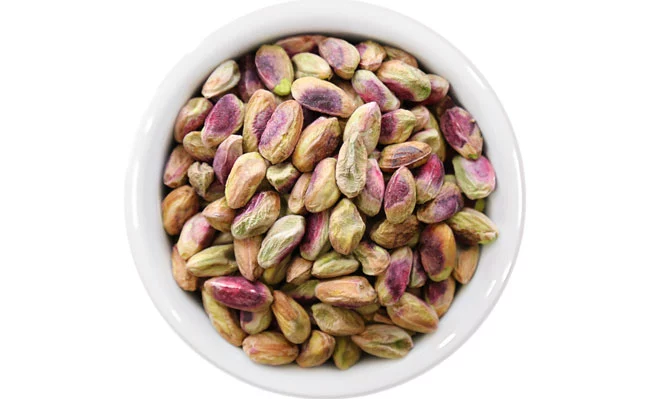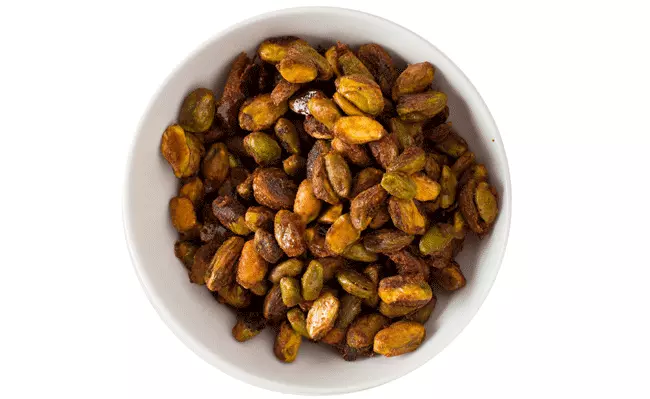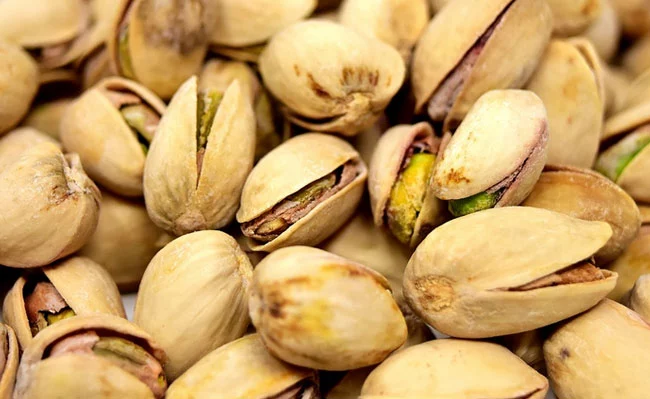Pistachios are very healthy nuts. They are filled with unsaturated fats, fiber, and protein. They also provide essential antioxidants and minerals. Studies show that there are several health benefits of eating pistachios. They help lower cholesterol, blood pressure, and blood sugar. In addition, the trend toward pistachio products is rising. However, some people want to know if roasting affects pistachios’ nutritional content and to what degree.
This article discusses the “raw vs roasted pistachios” debate. It highlights nutritional values and dietary differences and introduces a few ways of roasting. Hopefully, you will be able to decide easily by the end which raw vs roasted pistachios are better for you.
- What is Roasting?
- 5 Reasons Why We Roast Pistachios
- Main Ways of Roasting Pistachios
- Nutritional Differences between Raw vs Roasted Pistachios
- The Flavor Differences Between Raw and Roasted Pistachios
- The Potential Dangers of Roasted Pistachios
- The Potential Dangers of Raw Pistachios
- Which Type of Pistachio Should You Eat?
What is Roasting?
Roasting means cooking with dry heat, which evenly cooks the food on every side. Pistachios are gently shaken over the heat between 120 to 180 Degrees Celsius or pass through a medium heated by fire flames to roast. Unlike other nuts that are roasted without the shell, pistachios are roasted when they still have their shells or after shell removal. In either case, pistachios are first washed to lose their impurities, such as dust or dirt particles. They are then left to dry under the sun or in a dehydrator.
5 Reasons Why We Roast Pistachios
Pistachios are roasted for all or any of the following reasons.
1. To lose their shells
This method is mainly used to separate shells from kernels in cashews. We rarely roast pistachios to remove their shells, but we do sometimes toast shelled pistachios or pistachio kernels.
2. To enhance the taste and crunchy texture of pistachios
This is the main reason for roasting pistachios. Not all pistachios are treated at the same temperature. Some pistachios are “roastable,” meaning they can be baked over high heat. Roastability depends on variety (e.g., genetic structure) rather than region. But, heat-sensitive pistachios may not deliver a desirable taste and flavor like the heat-tolerant ones. Turkish pistachios and Iranian pistachios have more fat content. They are incredibly heat-tolerant. American pistachios are known to have less fat and less tolerance to roasting.
3. Roasting makes pistachios easier to eat
In addition to enhancing the taste and flavor of pistachios, roasting also makes pistachios more digestible. In other words, roasting can alter the way your body digests pistachios. A roasted nut is easier for your body to digest than a raw one. Roasted nuts are digested much more effectively, satisfying your hunger faster than raw nuts.
4. To add spice on pistachios
Pistachios taste better if they are covered with spices before they are roasted. Roasting stabilizes the spice in them.
5. To eliminate microbial contamination
Pistachios are roasted to remove their microbial contamination. It is believed that salmonella and aflatoxin cannot survive in the heat. However, study results have shown no significant difference between raw vs roasted pistachios in this case.
Main Ways of Roasting Pistachios
There are two main kinds of roasting:
Dry Roasting
Dry-roasting is when pistachios are roasted without oil or water. Nuts can be roasted at home in the oven or a frying pan for 15 minutes to one hour, depending on the temperature. You can alternatively use a microwave to toast your pistachios.
For industrial purposes, dry roasting occurs in a tunnel-type roaster machine. Thin layers of nuts on a multi-level conveyor belt move through a roasting chamber where flames from a heat exchanger roast the nuts on all sides. The temperature is set as high as 175°C, and the period is shortened to 10 minutes. In the end, a vertical flow of cool air is forced on the nuts to stop the roasting effect immediately. Pistachios are seasoned in a Salting Mixing Equipment before they are loaded into the roaster.
Sometimes, a mixing roaster rotating cylinder (set at 155°C to 175°C) is used instead of a conveyor belt. Pistachios are moved around in the machine. Gas-fired burners give an even distribution of heat and prevent scorching or burning.
Oil Roasting
Pistachios can be oil roasted in the oven, frying pan, or roasting machine. Before they are exposed to heat, pistachios are drizzled with oil and mixed gently until a thin layer of oil covers the surface of pistachios. Pistachios travel through the roaster continuously on a mesh conveyor belt. The oil makes pistachios susceptible to heat, giving them extra flavor. This method is called continuous roasting.
In a different method called batch oil roasting, the pistachios are placed in a stainless-steel basket. They are cooked by submerging them in cooking oil. Usually, unsaturated oil is used for this purpose. Some countries roast nuts in the same oil as the nut itself. For example, pistachios are oil-roasted in pistachio oil.
Nutritional Differences between Raw vs Roasted Pistachios
Raw and roasted pistachios have similar amounts of calories, protein, carbs, and fiber. However, roasting may slightly change the structure and chemical composition of nutrients. For example, the levels of B group vitamins reduce during roasting as they are not heat stable. This is not usually a problem since we get plenty of B vitamins from breads and cereal products. Roasting also changes the color and reduces the moisture content of pistachio, giving rise to their crunchy texture.


However, raw and roasted pistachios also contain very similar amounts and types of fats. Pistachios are so rich in fats that they cannot absorb a lot of extra oil during oil-roasting. According to research findings on roasted nuts, they absorb only 2-5% of the oil they are tossed in. For example, one ounce (28 grams) of raw almonds contains 161 calories and 14 grams of fat. But the same number of roasted almonds contains 167 calories and 15 grams of fat. Similarly, roasting may only convert a tiny portion (about 10%) of polyunsaturated fats into saturated fats (Spiller GA et al, 2003).
The same conclusion can be drawn for raw vs. roasted pistachios.One problem with oil- or dry-roasted pistachios is that they are usually pre-treated with salt. Salt is a known factor for increasing blood pressure. Raw pistachios, on the other hand, are free from salt.
The Flavor Differences Between Raw and Roasted Pistachios
Roasted pistachios kernels are more flavorful than raw kernels. The choice between them depends on whether you want a subtler or a more pronounced nutty flavor in your snacks or dishes. Raw pistachios have a mild, slightly sweet, and creamy flavor with a tender bite, making them ideal for recipes that require a delicate nut taste. In contrast, roasted pistachios develop a deeper, nuttier, and more robust flavor thanks to the Maillard reaction, which intensifies the natural taste of the nuts. Roasting also gives pistachios a crispier texture.The Potential Dangers of Roasted Pistachios
⭕ Altered Healthy Fats
Roasting can alter the healthy fats in pistachios. It may turn healthy fats such as monounsaturated or polyunsaturated fats into saturated fats. Healthy fats can reduce cholesterol in the blood and prevent heart disease. As mentioned earlier, roasted pistachios may absorb some of the oil they are tossed in.
⭕ Production of Free Radicals
High temperatures and long cooking times expose poly- and monounsaturated fats to heat. This can cause harmful free radicals to form. Free radicals are responsible for the “off” taste and smell of oxidized or rancid fat. Fortunately, by controlling the roasting process, you can reduce the formation of these free radicals.
⭕ The Loss of Heat-Sensitive Nutrients
Pistachios are a great source of nutrients such as minerals and vitamins to antioxidants. Some of these nutrients are heat sensitive and may be lost during roasting. For example, during roasting, certain types of antioxidants are degraded. Antioxidants are essential for the protection of cells against the harmful effects of free radicals.
⭕ Exceeding Maillard Reaction
The rich flavor, color, and aroma of roasted pistachios come from compounds formed during the Maillard reaction. Maillard reaction gives a brown surface to food when they roast. The reaction can happen at room temperature. The heat only accelerates the process, and the process accelerates when the temperature reaches 300°F (149°C). We want our pistachios to be brown, not burnt, blackened, or bitter tasting. But sometimes it happens when we are not paying attention.
⭕ Acrylamide Formation
When pistachios are roasted at high temperatures, a harmful substance called acrylamide may form in them. Raw pistachios contain 57 μg/kg of acrylamide. Sun-dried pistachios contain 93 μg/kg of acrylamide, which is a safe range. However, increasing temperature and time may lead to an increase in acrylamide levels. Acrylamide is a potential cause of cancer.
Experiments show that pre-treatment of pistachios with salt can lower acrylamide formation. For example, acrylamide formation is lower in hot-air and microwave methods than in unsalted pistachios.
⭕ Salt and Sugar Pretreatment
Roasted pistachios are often seasoned with salt, lemon, or even sugar. Salt and sugar are known causes of blood sugar spikes. So people with hypertension are advised to avoid salted-roasted pistachios.
The Potential Dangers of Raw Pistachios
When you decide between raw vs roasted pistachios, you have to consider their potential dangers. Raw and roasted pistachios have similar nutritional values and help minimize heart disease. But raw pistachios create a few health concerns. Such as the following:
⭕ Salmonella Infection
Raw pistachios may carry Salmonella. Roasting may reduce the risk of salmonella contamination and other harmful bacteria in nuts.
During harvesting, pistachios sometimes fall to the ground. They will quickly contact Salmonella if the soil is contaminated with bacteria. Contaminated water may also cause harmful bacteria contamination during or after harvesting. But the amount of Salmonella below the permitted level may not cause illness.
⭕ Aflatoxin Contamination
Aflatoxin can be found on raw and roasted pistachios. It is very resistant to heat and may survive the roasting process. Like Salmonella, aflatoxin contamination below the permitted level is safe.
In addition, pistachios may contain aflatoxin carcinogens. Some fungi produce aflatoxin carcinogens that may sometimes contaminate nuts and dried fruits. Salmonella and aflatoxin contamination is one of the disadvantages of pistachios. You can read “benefits and disadvantages of pistachio nuts” for more information.

Which Type of Pistachio Should You Eat?
The short answer is both of them. Both raw and roasted pistachios are safe if consumed in moderation.
Raw nuts may carry harmful bacteria, but they are very healthy. So, they probably won’t cause health problems as long as you keep track of your consumption.
Roasted pistachios are not harmful in serving amounts. Though they may have fewer antioxidants and vitamins. Some of their healthy fats may have turned into saturated forms. Sometimes acrylamide is formed in them. But that affects only a tiny portion of the total fats.
By optimizing the temperature and duration of roasting, we can lower the damage to the smallest possible amount. For example, by roasting pistachios at a low-to-medium temperature (284 °F or 140 °C) reduces vitamin loss, fat degradation, and acrylamide formation to the lowest amount.
People who like roasted pistachios should be careful. Some roasted pistachios sold in shops are seasoned with salt, and some are even sugar-coated.
Buy pistachios raw and roast them yourself instead of buying roasted nuts. You can do this in the microwave. In this way, you have better control over temperature and can roast larger quantities of nuts.
Read More :shelled pistachios
Conclusion
Raw vs roasted pistachios is a controversial issue. They both are excellent food sources and necessary for your health. They both have similar amounts of calories, protein, carbs, and fiber. However, roasting can slightly damage healthy fats. It may also alter nutrient contents, and cause acrylamide formation in pistachios.
On the other hand, raw nuts are more likely to contain harmful bacteria like Salmonella than roasted nuts. But these risks are low.
How pistachio nuts are roasted can significantly affect their nutrient content. If you roast them at home, keep the temperature relatively low for 15 minutes at around 284 ° F (140 ° C). The pistachios should come out with a color that indicates light roasting.
Do you usually buy roasted pistachios or do you buy raw pistachios and roast them at home? Which one do you prefer more?
Write your comments in the comment section.
FAQ


Wonderful product The natural sweetness of the pistachios comes through. No salt to get in the way or hamper heart health.